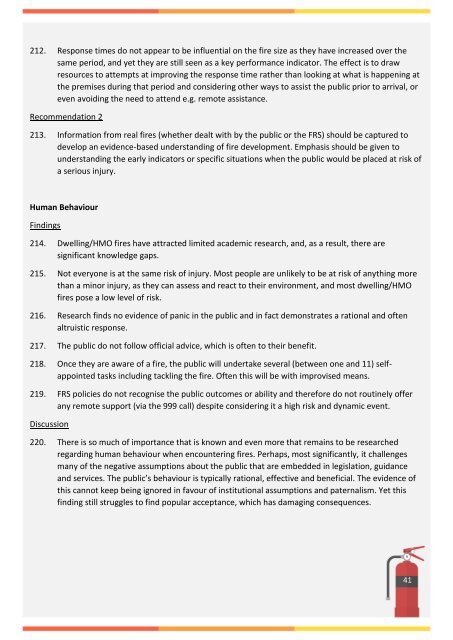An evaluation of the role of fire extinguishers
A report considering the role of a fire extinguisher in human terms identifying the gap between policy assumptions and the evidence from real fires. It considers the implications arising from this and makes a number of recommendations to create an evidence base and enhance current fire safety policies/advice.
A report considering the role of a fire extinguisher in human terms identifying the gap between policy assumptions and the evidence from real fires. It considers the implications arising from this and makes a number of recommendations to create an evidence base and enhance current fire safety policies/advice.
Create successful ePaper yourself
Turn your PDF publications into a flip-book with our unique Google optimized e-Paper software.
212. Response times do not appear to be influential on <strong>the</strong> <strong>fire</strong> size as <strong>the</strong>y have increased over <strong>the</strong><br />
same period, and yet <strong>the</strong>y are still seen as a key performance indicator. The effect is to draw<br />
resources to attempts at improving <strong>the</strong> response time ra<strong>the</strong>r than looking at what is happening at<br />
<strong>the</strong> premises during that period and considering o<strong>the</strong>r ways to assist <strong>the</strong> public prior to arrival, or<br />
even avoiding <strong>the</strong> need to attend e.g. remote assistance.<br />
Recommendation 2<br />
213. Information from real <strong>fire</strong>s (whe<strong>the</strong>r dealt with by <strong>the</strong> public or <strong>the</strong> FRS) should be captured to<br />
develop an evidence-based understanding <strong>of</strong> <strong>fire</strong> development. Emphasis should be given to<br />
understanding <strong>the</strong> early indicators or specific situations when <strong>the</strong> public would be placed at risk <strong>of</strong><br />
a serious injury.<br />
Human Behaviour<br />
Findings<br />
214. Dwelling/HMO <strong>fire</strong>s have attracted limited academic research, and, as a result, <strong>the</strong>re are<br />
significant knowledge gaps.<br />
215. Not everyone is at <strong>the</strong> same risk <strong>of</strong> injury. Most people are unlikely to be at risk <strong>of</strong> anything more<br />
than a minor injury, as <strong>the</strong>y can assess and react to <strong>the</strong>ir environment, and most dwelling/HMO<br />
<strong>fire</strong>s pose a low level <strong>of</strong> risk.<br />
216. Research finds no evidence <strong>of</strong> panic in <strong>the</strong> public and in fact demonstrates a rational and <strong>of</strong>ten<br />
altruistic response.<br />
217. The public do not follow <strong>of</strong>ficial advice, which is <strong>of</strong>ten to <strong>the</strong>ir benefit.<br />
218. Once <strong>the</strong>y are aware <strong>of</strong> a <strong>fire</strong>, <strong>the</strong> public will undertake several (between one and 11) selfappointed<br />
tasks including tackling <strong>the</strong> <strong>fire</strong>. Often this will be with improvised means.<br />
219. FRS policies do not recognise <strong>the</strong> public outcomes or ability and <strong>the</strong>refore do not routinely <strong>of</strong>fer<br />
any remote support (via <strong>the</strong> 999 call) despite considering it a high risk and dynamic event.<br />
Discussion<br />
220. There is so much <strong>of</strong> importance that is known and even more that remains to be researched<br />
regarding human behaviour when encountering <strong>fire</strong>s. Perhaps, most significantly, it challenges<br />
many <strong>of</strong> <strong>the</strong> negative assumptions about <strong>the</strong> public that are embedded in legislation, guidance<br />
and services. The public’s behaviour is typically rational, effective and beneficial. The evidence <strong>of</strong><br />
this cannot keep being ignored in favour <strong>of</strong> institutional assumptions and paternalism. Yet this<br />
finding still struggles to find popular acceptance, which has damaging consequences.<br />
41<br />
39




